Last week, you voted to explore a plane on which Auras represent the enchanted creature’s understanding of a myth’s lesson. This concept sprung up around totem armor with the idea that knowing the tales would help you survive, but it works at least as well with Angelic Destiny’s mechanic. As you age (and die), you pass stories on to the next generation.
A Bigger Sandbox
But before we make a decision about the mechanical elements, let’s form a clearer picture of exactly what’s happening on this plane:
Gaea’s Avatars disappeared so long ago that nobody alive ever saw them. Their deeds have been passed down as cautionary tales one generation to the next, but of late, some have begun to disregard these tales. Led by a young Shaman known as Benaho, some people argued that the tales are ancient and don’t apply to life today.
And indeed, it seemed that they did not. Those who forsook the ways of their ancestors began to question why things were as they were, and through this questioning, they made numerous discoveries. Life continued, until all at once, the beings of myth reappeared. They were, to say the least, displeased with the course things had taken. Many had their faith reaffirmed, but the most diehard of these new people, calling themselves Delvers, dismissed the Avatars. "See how much we have accomplished in your absence? Humanity stands stronger without your guidance!”
Outraged by this insolence, the beings of eld are bringing the very forces of nature to bear in an effort to quash the rebellion, but the Delvers have not fallen. With weapons of metal, they fight back. The fate of Kegree lies in the balance.
This isn’t turning out to be as enchantment-based as I would have liked when I said I wanted this to be the “mechanical equivalent of what Mirrodin was for artifacts.”
And that’s okay. Though Mark Rosewater puts Zendikar block solidly in the fourth stage of design, I think it’s a clear transition point. Yes, it was designed bottom-up from the lands-matter theme, but Zendikar was a far cry from being a land block. Creative started with lands and ended up making an adventure world. So, what did the design team do? They made quests (Quest for the Holy Relic), traps (Mindbreak Trap), and adventuring parties (Hada Freeblade). None of those have anything to do with lands, but they do help create an experience. When you play with Mirrodin Besieged, you’re at war; when you play with Innistrad or Dark Ascension, you’re trapped in a horror film; and when you play with Zendikar and Worldwake, you get just a taste of what it’s like to be an adventurer.
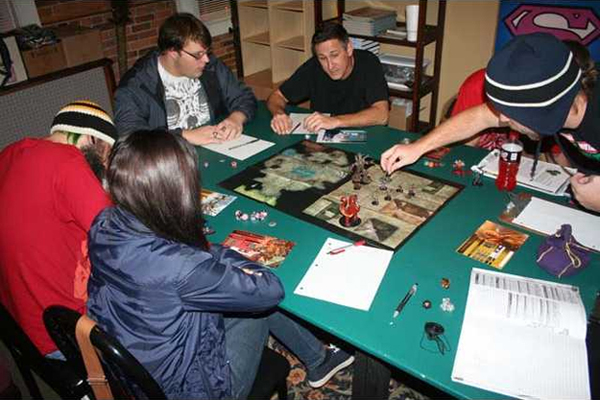
Photo by Seraine Page
When Zendikar released, I was underwhelmed. “If this is supposed to be a land block, why does only one mechanic care about lands?” I asked. Now Zendikar block disappoints me for another reason: Imagine how much more awesome it could have been if R&D had gone whole hog trying to make playing with it feel like adventuring.
The Here and Now
So, that begs the question: What happens here? The block as I’ve imagined it is a conflict between tradition and progress, between faith and skepticism, and ultimately, between one generation and the next. Can a Magic: The Gathering block tell an archetypal coming-of-age story? Probably not. But it can certainly show a conflict, and I don’t think that showing what each side values will be too difficult with the color pie on hand.
The conflicts I outlined above boil down to two enemy-color divides. White wants to build a stable community and is happy to follow a hierarchical power structure in order to do so. Red, on the other hand, wants freedom and individuality above all else. For the same reason that red resisted the Phyrexians for so long, it doesn’t want to follow the prescribed patterns set out by these old gods. On the other side, we find blue striving for understanding and progress while green distains meddling with the natural way of things.
The real question is what to do with black. We could take the Scars of Mirrodin approach and split it between the factions, but from a philosophical, standpoint black would probably side with the rebels to gain access to these new power sources. On the other hand, we probably want the Avatars’ supporters to make up a larger portion of the set so that they’ll subtly feel more like the norm.
Trial and Error
Either way, again like Scars, the factions need to be distinctive. We probably don’t need any watermarks here, but the scientific faction ought to feel pretty different from their shamanistic opposition. Magic has explored mage-sci before with the Izzet and Simic guilds in Ravnica and Jin-Gitaxias, Core Augur’s cronies Scars block.
This time, they’re a much more central piece of the design, and as such, I want to look for a mechanic that feels more like science.
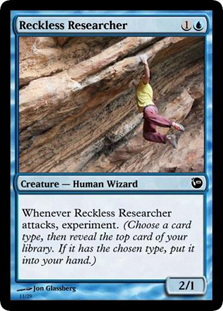
Given that experimenting is a weaker version of cantripping, we can use it as a rider on nonblue spells and repeatedly in blue—just like scry. The Delvers should also make some use of Equipment, but receiving bonuses for being equipped has been primarily white’s domain. We might be able to give their affinity for metallic weaponry a different feel if we do things more like this:
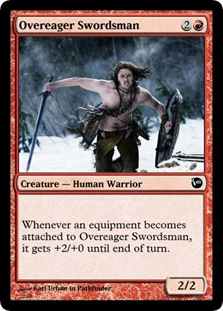
Then again, in addition to questions about activating equip abilities targeting the creature an Equipment is already attached to (which doesn’t work), this encourages a lot of unnecessary tossing back and forth, so maybe it’s unwarranted. I guess I just want some sort of sweet Glamer Spinners knock off . . . which brings us back to the original inspiration for this setting.
Samurai Jack
Now that we know what the true believers are up against, we can start to make decisions within context. First thing’s first: With a generational divide growing among the humans of Kegree, using the Angelic Destiny mechanic to represent passing stories from one generation to the next is a lot less appealing, so while we may change things later, let’s assume we’re using totem armor for now. In order to make the ability more relevant, we want to cut down on the number of cheap instant-speed removal spells in the format, which in turn boosts the power of combat tricks. That shouldn’t be an issue since we have so many creature enhancement slots devoted to Auras and Equipment as it is.
The other option is just to make a couple of build-your-own-monster strategies viable in Limited without making Auras really powerful in general. If we go down that route, we’ll need some creatures that are worth suiting up without being the unstoppable clock that is Invisible Stalker. I present Innocent Bystanders:
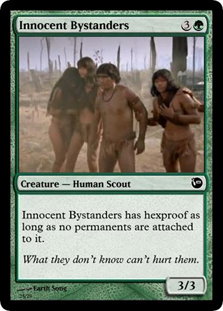
This might be a bit much for common, but if Stitcher's Apprentice is worth printing, this sort of complexity should be easy to rationalize. We could also use the longer “as long as it’s not equipped or enchanted” to make things clearer. Either way, it’s unfortunate to have an enhancement enabler read as though it doesn’t play well with them.
The Primordials
And at last, we come to the Avatars that sculpted this plane from the raw essence of the multiverse. Having lived without their presence for so long, humanity naturally assumed that creation had ended, but after having read Wobbles’s old post about a newly forming plane, I’m convinced that it would be a lot more exciting to have creation ongoing during the block. After all, what are a few thousand years on the timescale of gods?
With their newly altered identity, these primordials deserve to hold a bit more of the set’s excitement, so the mortals are probably going to have to foot the small vanillas this time around. Sorry, Brother Wolf!
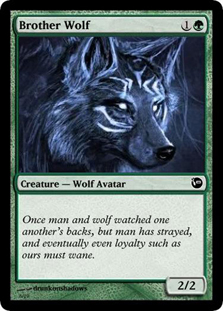
My first thought is to use the technology first previewed by Fencer's Magemark and friends. Then again, in last week’s comments, Wobbles referred to this cycle as “uninspired.” This isn’t meant to single him out or anything; it’s more that I think this effect highlights an interesting divide in the player base. I was an extremely casual player when Guildpact released, and I didn’t even realize that the Magemarks affected more creatures than those they were attached to until somebody pointed it out during a game. That blew my mind.
On the other end of the spectrum, somebody deep into Magic will almost immediately notice the strange wording and figure out what’s going on. Here, the trick feels cheap, and the cards hold little appeal. It’s unfortunate that the players most likely to be impressed by the ability are the most likely to miss it, but putting it on creatures does a lot to diminish these issues. Then again, it leads to abilities that do nothing on their own—I’m still willing to at least give it a shot:
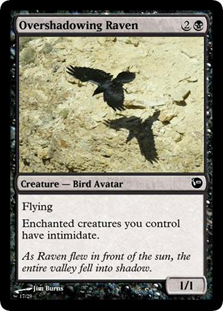
The Next Chapter
There’s a lot more to talk about here, but I have a PTQ to prepare for, so it’ll have to wait until next week. In the meantime, I’d love to hear everyone’s thoughts on what we’ve covered thus far and where we’re going.
Until then,
Jules Robins
julesdrobins at gmail dot com

























